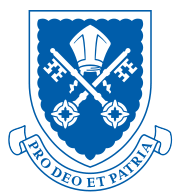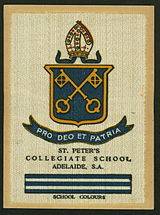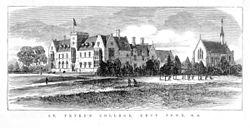- St Peter's College, Adelaide
-
St Peter's College 
Location Adelaide, South Australia, Australia Information Type Independent Anglican School For Boys Motto Pro Deo et Patria
'For God and Country'Established 15 July 1847 Headmaster Mr Simon Murray[1] Chaplain Revd. Theo Macall Grades R–12 Enrolment 1,270 Campus Hackney, Finniss Colour(s) Royal Blue and White Affiliations Anglican Church Website www.stpeters.sa.edu.au St Peter's College, (officially The Collegiate School of St Peter, but commonly known as SPSC, St Peter's or Saints), is an independent boy's school in the South Australian capital of Adelaide. Founded in 1847 by members of the Anglican Church of Australia, the school is noted for its famous alumni, including three Nobel laureates and forty-one Rhodes scholars.
Three campuses are located on the Hackney Road site near the Adelaide Parklands in Hackney.The Senior School (years 8-12) comprises the bulk of the grounds and most of the historic buildings. To the south of the site are the Preparatory School (years 3-7) and Palm House (reception-year 2). The College also owns an outdoor education campus in Finniss, near Lake Alexandrina. The School is a member of the G20 Schools group.
St Peter's is a day and boarding school and offers two matriculation streams in secondary education: the South Australian Certificate of Education (SACE) and the International Baccalaureate Diploma (IB).
In 2010 The Age reported that St Peter's College ranked equal fourth among Australian schools based on the number of alumni who had received a top Order of Australia honour.[2]
Contents
History
 Collectable Australian School Cigarette card featuring the St Peter's College colours & crest, c. 1920's.
Collectable Australian School Cigarette card featuring the St Peter's College colours & crest, c. 1920's.
The origins of the school lie in the ambition of the early colonists to establish for their sons an institution equivalent to the Public Schools from which they benefitted in Great Britain. They founded the Church of England Collegiate School of South Australia, or "The Collegiate School", as a proprietary school on 15 July 1847 in the schoolroom of Holy Trinity Church on North Terrace. The name Sancti Petri Schola Collegiata (SPSC) was given. The school's foundation was followed by the arrival of the first Bishop of Adelaide Augustus Short in December 1847. Short brought with him an endowment of £2,000 from the Society for Promoting Christian Knowledge with which he was expected establish an institution for the Church of England. He intended to use the Trinity School as the basis for this institution and had his chaplain the Reverend T.P. Wilson appointed as its Head Master. He also purchased the school's current estate in Hackney.[3]
In 1849, negotiations between Short and the proprietors concluded, and a Council of Governors was established per their agreement. The school was rededicated as the Collegiate School of St Peter upon incorporation in July 1849. The Latin translation, Sancti Petri Schola Collegiata, is still used as the school acronym, SPSC, although it is often Anglicised to "St Peter's School Collegiate".
Emblem
The school's emblem consists of a blue shield with white trim, surmounted by two golden keys and bishop's mitre (contemporary versions place the mitre within rather than above the shield, dissimilating the emblem from that of the Diocese of Gloucester). The keys represent Saint Peter while the mitre represents the school's link to the Anglican Church. Beneath the shield is a scroll with the school's Latin motto "Pro Deo et Patria", in which translates into English as "For God and Country".
House system
Upon entering the Senior School in Year 8, all boys are assigned to a house. There are 10 houses, each named after prominent figures in the school's history.[4] Four of these—Da Costa, Farrell, Hawkes and Short—were the original four houses founded in 1920. To accommodate the growing student population five additional houses were founded: MacDermott, Woodcock, Young, Howard and Farr. There is also a boarding house—School & Allen House, that was established in 2003 through the amalgamation of School House with Wyatt & Allen. Houses meet several times each week, and compete in various intra-school competitions throughout the year.
Campus
The school is situated on 32 hectares of landscaped grounds only 3 kilometres from the Adelaide central business district on Hackney Road and North Terrace in the suburb St Peters. The suburb St. Peters and its neighbour College Park were named after the school. The main campus' facilities include seven ovals, a hockey pitch, ten tennis courts and two swimming pools. It features mostly heritage architecture, such as "Palm House" (built for William Peacock), but also includes modern buildings. The "Big School Room" is thought to be Australia's oldest classroom still in constant use.
The most recent addition to the school has been the extensive redevelopment of the Junior School, featuring new classrooms and lecture facilitates as well as South Australia's only school based Observatory. In the Senior school the sports centre is the most recent development, which includes two basketball courts, a 25 metre pool, a diving pool, a weights and conditioning room, and café. The school has completed the refurbishment of the old gymnasium as the new Drama Centre and is soon to commence construction of the 'Leadership and Ethics Centre' featuring lecture facilities, a new year 12 common room and the school's museum.
The College also owns an outdoor education property in Finniss, situated on several hectares of land on the banks of the River Finniss. The property includes dormitories, teacher accommodation and a gymnasium, and students are involved with the property's revegetation program of native flora.
Endowments
A significant source of the school's revenue is the estate of Benjamin Mendes da Costa. Da Costa, a successful Adelaide businessman, bequeathed his estate of £20,000 to the Collegiate School of St Peter when he died in 1868.[3] The bequest was subject to the life interests of ten relations; the last surviving relation died in 1910 and in 1912 the property was vested in the school.[5] A large portion of the estate remains land in prominent city-centre locations. Income generated by the estate is used to subsidise the fees of all students, along with several scholarships and bursaries.
A somewhat common Adelaidean urban myth asserts that the da Costa estate was intended to be given to the Catholic church rather than the Anglican, and that the funds were awarded to Saints after a supposed legal battle. This myth has no basis in fact and most probably stems from misconceptions of da Costa's religion due to his Portuguese family name.
St Peter's College sold Da Costa Arcade, near Rundle Mall, in 2005.
Extracurricular activities
Sport
Each student at St Peters is required to play both a summer and winter sport.
Staff and past students conduct training sessions. Weekend competitions are held at the school (or at away venues) each weekend against other schools in Adelaide. Each sport has an annual intercollegiate showdown against rivals Prince Alfred College, known as the "Intercol".[6][7] Some intercols include Head of the River, Football showdown, Water Polo and The Basketball.
Music
The school runs an extensive music program which encourages students to study musical instruments and perform in ensembles. These ensembles perform in several concerts throughout the year, both within the school and externally. Groups include an intermediate and a senior concert band, senior choir, orchestra, string orchestra, and two stage bands until recently named after prominent Australian jazz musicians James Morrison and Don Burrows.
Outdoor Education
The Outdoor Education campus at Finniss is used by students from years 4 to 10 for annual camps. In addition, students have the opportunity to join the Exploration Society, which allows boys with a passion for outdoor activities to pursue more challenging ventures. Activities include hiking, kayaking, rockclimbing, mountain bike touring and cross country skiing.
Exchange Program
St Peter's College's exchange program has links with schools in Germany, France, China, South Africa, England, Switzerland and Canada.
Notable alumni
St Peter's position as a leading Adelaide school has seen many of its former students achieve renown in a variety of fields. It has educated more Nobel laureates than any other school in Australia,[8]
St Peter's alumni include:
- Three Nobel Prize winners:
- William Lawrence Bragg (Nobel prize in Physics, 1915)[9]
- Howard Walter Florey (Nobel prize in Physiology or Medicine, 1945)[10]
- J. Robin Warren (Nobel prize in Physiology or Medicine, 2005) [11]
- 42 Rhodes Scholars[12]
- Eight premiers of South Australia:
- Sir John Cox Bray (1881–1884)[13]
- Sir John Downer (1885–1887 and 1892–1893)[14]
- Sir Frederick Holder (1892 and 1899–1901)
- Sir Richard Butler (1905)[15]
- Sir Henry Barwell (1920–1924)[16]
- Don Dunstan (1967–1968, and 1970–1979)[17]
- David Tonkin (1979–1982)
- John Bannon (1982–1992)[18]
- One premier of Western Australia:
- George Leake (1901; 1901–1902))[20]
- Two Victoria Crosses:
- Arthur Seaforth Blackburn VC CMG CBE, soldier and lawyer; awarded the Victoria Cross in 1916.[21]
- Guy George Egerton Wylly VC CB DSO, army officer; awarded the Victoria Cross in 1900.[22]
- Contemporary sportsmen:
- Tom Harley (Two time premiership captain with the Geelong Football Club)
- Will Minson (Current Player with the Western Bulldogs Football Club)
- Darren Ng (Current Player with the Adelaide 36ers Basketball Club)
- Hayden Stoeckel (Olympic swimmer, bronze and silver medallist at 2008 Olympics)
- Nathan Adcock (cricketer, former captain of Southern Redbacks)
- And other well known figures, including:
- Andy Thomas, astronaut
- Scott Hicks, film director
- Keith Conlon, OAM, Television and radio personality
- Hugh Possingham, Conservation & environmental planning expert, applied mathematician, academic
- Walter Bagot, Architect, founder of Woods Bagot[23]
- Ian George, former Archbishop of Adelaide
- Sir James Hardy, three times America's Cup skipper and renowned winemaker
- Harold David Anderson, OBE, former Ambassador
- Sir Denzil Ibbetson, administrator in British India, author
See also
References
- ^ http://news.stpeters.sa.edu.au/2009/06/a-message-from-the-chairman/
- ^ Topsfield, Jewel (4 December 2010). "Ties that bind prove a private education has its awards". The Age. p. 11. http://www.theage.com.au/national/education/ties-that-bind-prove-a-private-education-has-its-awards-20101203-18jx0.html?from=age_sb. The hard copy article also published a table of the schools which were ranked in the top ten places, as follows: (1st with 19 awards) Scotch College, Melbourne, (2nd with 17 awards) Geelong Grammar School, (3rd with 13 awards) Sydney Boys High School, (equal 4th with 10 awards each) Fort Street High School, Perth Modern School and St Peter's College, Adelaide, (equal 7th with 9 awards each) Melbourne Grammar School, North Sydney Boys High School and The King's School, Parramatta, (equal 10th with 6 awards each) Launceston Grammar School, Melbourne High School, Wesley College, Melbourne and Xavier College.
- ^ a b John Tregenza, "Collegiate School of St Peter, Adelaide, The Founding Years 1847-1878", 1996.
- ^ "School Houses". St Peter's College. http://stpeters.sa.edu.au/#/About_Saints/School_Houses/. Retrieved 25 August 2010.
- ^ Miller, J. S. C. (1974). "Mendes da Costa, Benjamin (1803 - 1868)". Australian Dictionary of Biography. http://www.adb.online.anu.edu.au/biogs/A050272b.htm. Retrieved 2006-09-19.
- ^ Bednall, Jai (Wednesday, 26 May 2010). "PAC sends early - Intercol warning". Messenger - Eastern Courier (Adelaide, Australia).
- ^ Gordon, Danielle (Tuesday, 26 December 2000). "Princes reign in Intercol rivalry". The Advertiser (Adelaide, Australia).
- ^ Australia has produced nine Nobel Laureates. The six others are:
- Frank MacFarlane Burnet 1960 Nobel Prize in Physiology or Medicine (educated Geelong College),
- John Cornforth 1975 Nobel Prize in Chemistry (educated at Sydney Boys High School),
- John Eccles 1963 Nobel Prize in Physiology or Medicine (educated at Melbourne High School),
- Patrick White 1973 Nobel Prize for Literature (educated in country NSW and England),
- Peter C. Doherty 1996 Nobel Prize in Physiology or Medicine (educated at public high school in Brisbane) and
- Barry Marshall 2005 Nobel Prize in Physiology or Medicine (educated at public high schools in Perth).
All details from individual winners bios at http://nobelprize.org - ^ Lawrence Bragg - Biography
- ^ Sir Howard Florey - Biography
- ^ J. Robin Warren - Autobiography
- ^ List of South Australian Rhodes Scholars
- ^ Bray, Sir John Cox (1842 - 1894) Biographical Entry - Australian Dictionary of Biography Online
- ^ http://www.adb.online.anu.edu.au/biogs/A080355b.htm?hilite=Sir%3BJohn%3BDowner
- ^ http://www.adb.online.anu.edu.au/biogs/A070510b.htm?hilite=richard%3Bbutler
- ^ http://www.adb.online.anu.edu.au/biogs/A070203b.htm?hilite=henry%3Bbarwell
- ^ Don Dunstan Foundation | Don Dunstan: A life of achievement
- ^ Research Centre for the History of Food and Drink
- ^ Thomas Lancelot Lewis (1922 - )
- ^ Leake, George (1856 - 1902)
- ^ Blackburn, R.A (1979). "Blackburn, Arthur Seaforth (1892 - 1960)". Australian Dictionary of Biography. 7 (Online ed.). Melbourne: Melbourne University Press. pp. 307–308. http://www.adb.online.anu.edu.au/biogs/A070315b.htm?hilite=Victoria+Cross. Retrieved 2008-01-23.. Blackburn also attended Pulteney Grammar School.
- ^ Sweeting, A.J (1990). "Wylly, Guy George Egerton (1880 - 1962)". Australian Dictionary of Biography. 12 (Online ed.). Melbourne: Melbourne University Press. pp. 589–590. http://www.adb.online.anu.edu.au/biogs/A120658b.htm?hilite=Victoria+Cross. Retrieved 2008-01-23.. Wylly also attended The Hutchins School.
- ^ http://www.adb.online.anu.edu.au/biogs/A070138b.htm?hilite=Walter%3BBagot
External links
Members of the Sports Association for Adelaide Schools, South Australia Adelaide High School • Blackfriars Priory School • Cabra Dominican College • Christian Brothers College • Concordia College • Gleeson College • Glenunga International High School • Immanuel College • Marryatville High School • Mercedes College • Nazareth Catholic College • Norwood Morialta High School • Pedare Christian College • Pembroke School • Prince Alfred College • Pulteney Grammar School • Rostrevor College • Sacred Heart College Middle School • Sacred Heart College • St Andrew's School • St Ignatius' College • St John's Grammar School • St John's Lutheran, Highgate (Tennis only) • St Michael's College • St Paul's College • St Peter's College • Scotch College • Trinity College • Unley High School • Westminster School • Woodcroft CollegeCategories:- Anglican schools in Australia
- Educational institutions established in 1847
- Boarding schools in South Australia
- Member schools of the Headmasters' and Headmistresses' Conference
- Private schools in South Australia
- High schools in South Australia
- Boys' schools in Australia
- Junior School Heads Association of Australia Member Schools
- Primary schools in South Australia
- International Baccalaureate schools in Australia
- Schools in Adelaide
- Three Nobel Prize winners:
Wikimedia Foundation. 2010.

